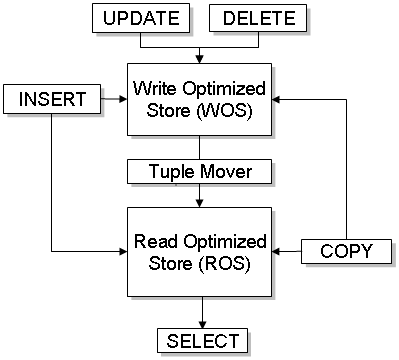Advanced Storage Control
The tuple mover is the component of Vertica that moves the contents of the  Write Optimized Store (WOS) into the
Write Optimized Store (WOS) into the  Read Optimized Store (ROS). This data movement is known as a moveout. Normally, the tuple mover runs automatically in the background at preset intervals and is referred to as the ATM.
Read Optimized Store (ROS). This data movement is known as a moveout. Normally, the tuple mover runs automatically in the background at preset intervals and is referred to as the ATM.
The ROS (Read Optimized Store) is a highly optimized, read-oriented, physical storage structure that is organized by projection and that makes heavy use of  compression and indexing. You can use the COPY...DIRECT and INSERT (with direct hint) statements to load data directly into the ROS.
compression and indexing. You can use the COPY...DIRECT and INSERT (with direct hint) statements to load data directly into the ROS.
Compression is the process of transforming data into a more compact format. Compressed data cannot be directly processed; it must first be decompressed. Vertica uses integer packing for unencoded integers and  LZO for compressible data. Although compression is generally considered to be a form of encoding, the terms have different meanings in Vertica.
LZO for compressible data. Although compression is generally considered to be a form of encoding, the terms have different meanings in Vertica.
LZO is an abbreviation for Lempel-Ziv-Oberhumer. It is a data compression algorithm that is focused on decompression speed. The algorithm is lossless and the reference implementation is thread safe.
The WOS (Write Optimized Store) is a memory-resident data structure into which INSERT, UPDATE, DELETE, and COPY (without DIRECT hint) actions are recorded. Like the  ROS, the WOS is arranged by projection but it stores tuples without sorting,
ROS, the WOS is arranged by projection but it stores tuples without sorting,  compression, or indexing and thus supports very fast load speeds. The WOS organizes data by epoch and holds uncommitted transaction data.
compression, or indexing and thus supports very fast load speeds. The WOS organizes data by epoch and holds uncommitted transaction data.
Compression is the process of transforming data into a more compact format. Compressed data cannot be directly processed; it must first be decompressed. Vertica uses integer packing for unencoded integers and  LZO for compressible data. Although compression is generally considered to be a form of encoding, the terms have different meanings in Vertica.
LZO for compressible data. Although compression is generally considered to be a form of encoding, the terms have different meanings in Vertica.
LZO is an abbreviation for Lempel-Ziv-Oberhumer. It is a data compression algorithm that is focused on decompression speed. The algorithm is lossless and the reference implementation is thread safe.
The ROS (Read Optimized Store) is a highly optimized, read-oriented, physical storage structure that is organized by projection and that makes heavy use of  compression and indexing. You can use the COPY...DIRECT and INSERT (with direct hint) statements to load data directly into the ROS.
compression and indexing. You can use the COPY...DIRECT and INSERT (with direct hint) statements to load data directly into the ROS.
Compression is the process of transforming data into a more compact format. Compressed data cannot be directly processed; it must first be decompressed. Vertica uses integer packing for unencoded integers and  LZO for compressible data. Although compression is generally considered to be a form of encoding, the terms have different meanings in Vertica.
LZO for compressible data. Although compression is generally considered to be a form of encoding, the terms have different meanings in Vertica.
LZO is an abbreviation for Lempel-Ziv-Oberhumer. It is a data compression algorithm that is focused on decompression speed. The algorithm is lossless and the reference implementation is thread safe.

Under ordinary circumstances, the operations performed by the tuple mover are automatic and transparent, and thus of little or no concern to the database administrator. However, when loading data, certain conditions require that you stop the ATM, perform some operations manually, and restart the ATM. This section describes what the automatic operations are and how to perform them manually.
 Write Optimized Store (WOS) into the
Write Optimized Store (WOS) into the  Read Optimized Store (ROS). This data movement is known as a moveout. Normally, the tuple mover runs automatically in the background at preset intervals and is referred to as the ATM.
Read Optimized Store (ROS). This data movement is known as a moveout. Normally, the tuple mover runs automatically in the background at preset intervals and is referred to as the ATM.